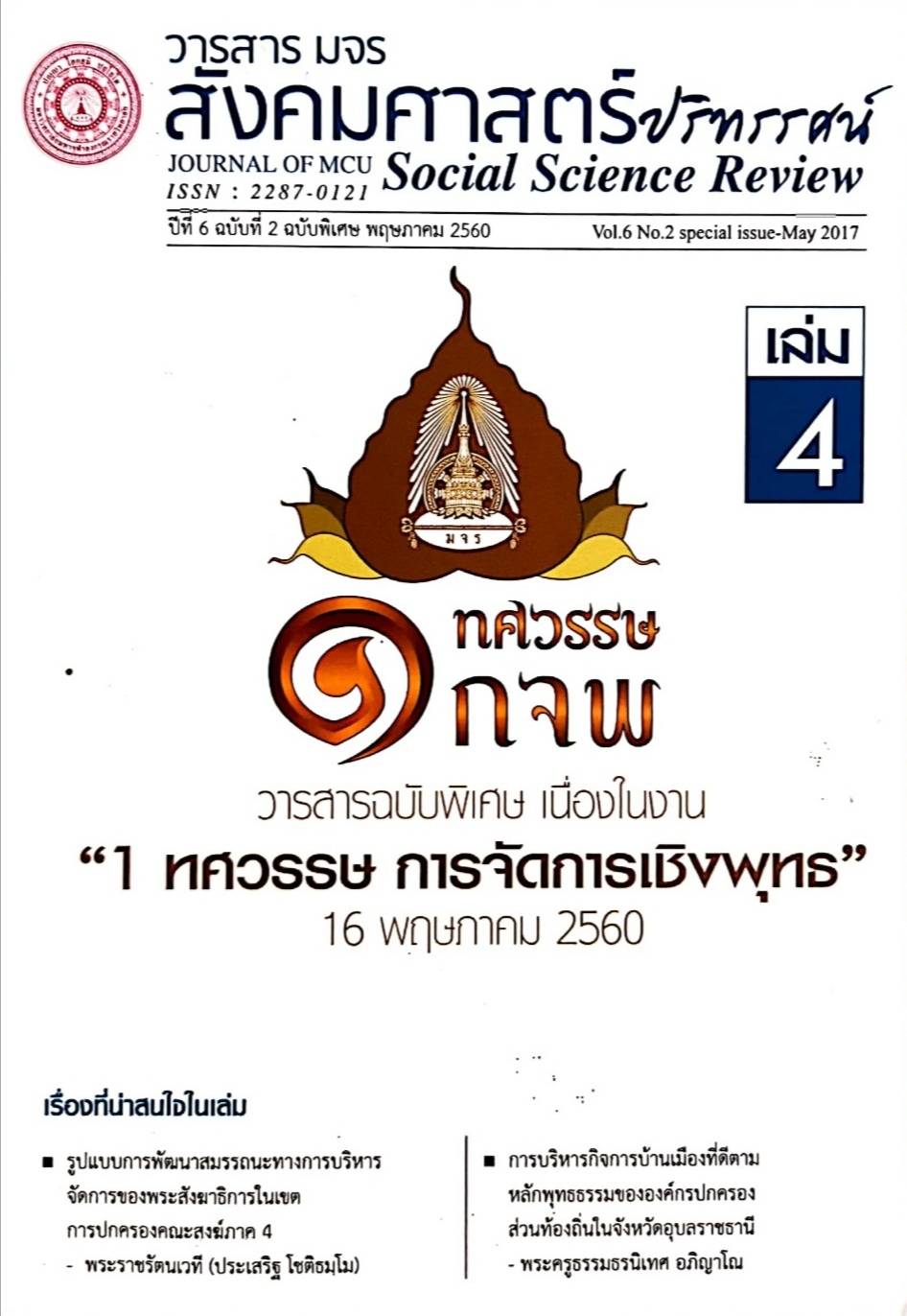รูปแบบการพัฒนาบึงน้าขนาดใหญ่แบบมีส่วนร่วมในสังคมไทย
คำสำคัญ:
การมีส่วนร่วม, การพัฒนา, การพัฒนาแบบมีส่วนร่วมบทคัดย่อ
การวิจัยในเรื่องนี้มีวัตถุประสงค์คือ 1) เพื่อศึกษาสภาพการเปลี่ยนแปลงและพัฒนาการ
ของบึงบอระเพ็ด จังหวัดนครสวรรค์ 2) เพื่อสังเคราะห์รูปแบบการพัฒนาบึงบอระเพ็ด จังหวัด
นครสวรรค์แบบมีส่วนร่วม และ 3) เพื่อประเมินผลรูปแบบการพัฒนาบึงบอระเพ็ดแบบมีส่วนร่วม
ตามความคิดเห็นของประชาชนและผู้มีส่วนได้เสีย โดยใช้ระเบียบวิธีวิจัยแบบผสานวิธีระหว่างการ
วิจัยเชิงคุณภาพโดยการการสัมภาษณ์เชิงลึกและการสนทนากลุ่มเฉพาะเพื่อพัฒนารูปแบบการมี
ส่วนร่วม และการวิจัยเชิงปริมาณเพื่อขอรับการยืนยันจากกลุ่มตัวอย่าง 400 คน ผลการวิจัยพบว่า
1. ปัจจุบันบึงบอระเพ็ดมีการเปลี่ยนแปลงพัฒนา คือ 1) มีการก่อสร้างฝายน้าล้นเพื่อ
ยกระดับน้าเมื่อปี 2469 2) มีการสร้างประตูกั้นน้าคลองบึงบอระเพ็ด 3) ชุมชนโดยรอบมีความ
หนาแน่นขึ้น 4) มีการหลั่งไหลของข้อมูลข่าวสารและวัฒนธรรมจากแหล่งอื่นเข้าไปในชุมชน 5) มี
การปรับเปลี่ยนอาชีพจากเกษตรและการประมงเพื่อการยังชีพเป็นเพื่อธุรกิจการค้าและเพื่อการ
ส่งออก 6) มีการขยายตัวของชุมชนท้าให้พื้นที่ในการรองรับน้าให้เล็กลงและยังกีดขวางเส้นทางเดิน
ของน้าในฤดูน้าหลาก 7) มีการเปลี่ยนแปลงวิถีชีวิตของคนในชุมชนรอบบึงบอระเพ็ดในเกือบทุกมิติ
จากผลพวงของความเจริญ 8) มีการใช้สารเคมี ยาฆ่าแมลงสารพัดรูปแบบ ท้าให้เกิดสารพิษตกค้าง
และระบบนิเวศถูกท้าลาย และ 9) มีการแปลงสินทรัพย์ (บึงบอระเพ็ด) ให้เป็นทุนทั้งจากภาครัฐ
และภาคเอกชน
2. การมีส่วนร่วมในการพัฒนาบึงบอระเพ็ด 1) ด้านการรับรู้ข้อมูลข่าวสารจะต้องมีความ
โปร่งใส ชัดเจนไม่คลุมเครือ ปราศจากการบิดเบือน 2) ด้านการรับฟังความคิดเห็นควรเกิดขึ้นใน
บรรยากาศของความพร้อมเพรียง สามัคคี มีความไว้เนื้อเชื่อใจและมีน้าใจต่อกัน 3) ด้านการ
ตัดสินใจควรมีเหตุมีผล ถูกต้องชอบธรรม พอเพียงพอประมาณ และเพื่อประโยชน์ส่วนรวม 4) ด้าน
การสนับสนุนร่วมมือควรถูกต้องตามกฎ ระเบียบ ข้อบังคับ บริสุทธิ์ สะอาด ปราศจากผลประโยชน์
แอบแฝง และ 5) ด้านการเสริมอ้านาจควรมีเพื่อการยับยั้ง ทบทวน เมื่อพบว่าการพัฒนาจะส่งผล
กระทบต่อชุมชนและท้องถิ่น 3. รูปแบบการพัฒนาบึงน้าขนาดใหญ่แบบมีส่วนร่วมในสังคมไทยจะต้องเริ่มต้นด้วยเรื่อง
ของการรับรู้ข่าวสารซึ่งเป็นสิ่งจ้าเป็นสูงสุด รองลงมาได้แก่ การสนับสนุนร่วมมือ การรับฟังความ
คิดเห็น การมีส่วนร่วมในการตัดสินใจ และการเสริมอ้านาจให้แก่ประชาชนซึ่งเป็นแนวทางที่จะมี
ส่วนร่วมน้อยกว่าทุกด้าน
เอกสารอ้างอิง
ห้วยทับทันจังหวัดศรีสะเกษ”. วิทยานิพนธ์รัฐประศาสนศาสตรมหาบัณฑิต. บัณฑิต
วิทยาลัย : สถาบันบัณฑิตพัฒนบริหารศาสตร์.
ชัยศรี ธาราสวัสดิ์พิพัฒน์ และคณะ. (2554). “การพัฒนาแนวทางการจัดการน้าเสียแบบชุมชนมี
ส่วนร่วมของตลาดน้าวัดล้าพญา อ้าเภอบางเลน จังหวัดนครปฐม”. รายงานวิจัย.
กรุงเทพมหานคร : กรมส่งเสริมคุณภาพสิ่งแวดล้อม.
เทพฤทธิ์ เจริญศรี. (2544). การมีส่วนร่วมของชุมชนในการ จัดการอนุรักษ์ป่าลุ่มน้าชมพู :
กรณีศึกษา ต้าบลชมพู อ้าเภอเนินมะปราง จังหวัดพิษณุโลก. วิทยานิพนธ์ศิลปศาสตร์
มหาบัณฑิต (รัฐศาสตร์). บัณฑิตวิทยาลัย : มหาวิทยาลัยรามค้าแหง.
บุญชัย งามวิทย์โรจน์ และคณะ. (2552). “การเสริมสร้างและพัฒนากระบวนการมีส่วนร่วมของ
ชุมชนท้องถิ่นในการบริหารจัดการทรัพยากรน้าและป่าต้นน้า กรณีศึกษาลุ่มน้าปิงและลุ่ม
น้าชายฝั่งทะเลตะวันออก”. รายงานวิจัย. กรุงเทพมหานคร : กรมทรัพยากรน้า
กระทรวงทรัพยากรธรรมชาติและสิ่งแวดล้อม.
เบญจมาศ สวนศิลป์พงศ์. (2552). “โครงสร้างอ้านาจในชุมชน : ศึกษากรณีการมีส่วนร่วมกิจกรรม
ชุมชนแออัดทางรถไฟเขตดุสิต กรุงเทพมหานคร”. วิทยานิพนธ์รัฐศาสตรมหาบัณฑิต.
บัณฑิตวิทยาลัย : มหาวิทยาลัยธรรมศาสตร์.
พระมหาหรรษา ธมฺมหาโส (นิธิบุณยากร). (2548). “รูปแบบการจัดการความขัดแย้งโดยพุทธสันติ
วิธี : ศึกษาวิเคราะห์กรณีลุ่มน้าตาช้าง จ.เชียงใหม่”. วิทยานิพนธ์พุทธศาสตรดุษฎีบัณฑิต
(พระพุทธศาสนา). บัณฑิตวิทยาลัย มหาวิทยาลัยมหาจุฬาลงกรณ์ราชวิทยาลัย.
เสรี ซาเหลา และคณะ. (2545).“การเปลี่ยนแปลงวิถีชีวิตชุมชนรอบบึงบอระเพ็ดจังหวัด
นครสวรรค์”. รายงานวิจัย. นครสวรรค์ : มหาวิทยาลัยราชภัฏนครสวรรค์.
United Nation. (1981). “Popular Participation asa Strategy for Promoting Community
Level Action and Nation Development Report of The Meeting for The
Adhoc Group of Expert”. Department of Internation Economic and Social
Affair. New York: United Nation.
ดาวน์โหลด
เผยแพร่แล้ว
รูปแบบการอ้างอิง
ฉบับ
ประเภทบทความ
สัญญาอนุญาต
ลิขสิทธิ์ (c) 2020 วารสาร มจร สังคมศาสตร์ปริทรรศน์

อนุญาตภายใต้เงื่อนไข Creative Commons Attribution-NonCommercial-NoDerivatives 4.0 International License.
เพื่อให้เป็นไปตามกฎหมายลิขสิทธิ์ ผู้นิพนธ์ทุกท่านต้องลงลายมือชื่อในแบบฟอร์มใบมอบลิขสิทธิ์บทความให้แก่วารสารฯ พร้อมกับบทความต้นฉบับที่ได้แก้ไขครั้งสุดท้าย นอกจากนี้ ผู้นิพนธ์ทุกท่านต้องยืนยันว่าบทความต้นฉบับที่ส่งมาตีพิมพ์นั้น ได้ส่งมาตีพิมพ์เฉพาะในวารสาร มจร สังคมศาสตร์ปริทรรศน์ เพียงแห่งเดียวเท่านั้น หากมีการใช้ภาพหรือตารางหรือเนื้อหาอื่นๆ ของผู้นิพนธ์อื่นที่ปรากฏในสิ่งตีพิมพ์อื่นมาแล้ว ผู้นิพนธ์ต้องขออนุญาตเจ้าของลิขสิทธิ์ก่อน พร้อมทั้งแสดงหนังสือที่ได้รับการยินยอมต่อบรรณาธิการ ก่อนที่บทความจะได้รับการตีพิมพ์ หากไม่เป็นไปตามข้อกำหนดเบื้องต้น ทางวารสารจะถอดบทความของท่านออกโดยไม่มีข้อยกเว้นใดๆ ทั้งสิ้น





